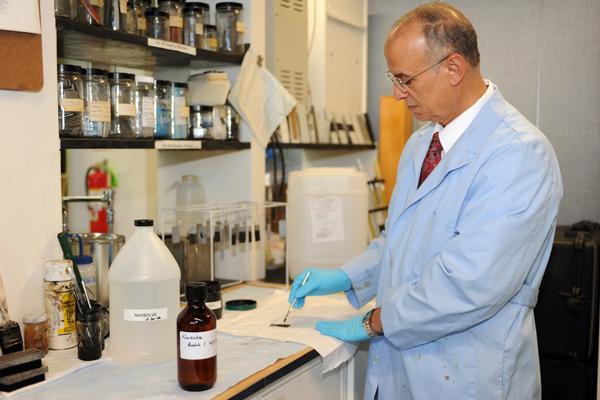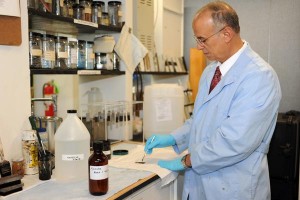Navy Invents Green Cleaner


Dr. El Sayed Arafat from NAWCAD's Materials Lab, prepares a washing effectiveness test using the new Type II cleaning solvent called NAVSOLVE recently patented by the U.S. Navy. (U.S. Navy photo)
By NAWCAD Public Affairs
Cleaning old grease from aircraft or automotive parts is a messy business. In the past, the Navy used petroleum based solvents–great on grease but not so great for the environment.
Now, there’s an environmentally friendly solution called NAVSOLVE that the Department of Defense (DoD) is embracing. In fact, The Office of the Secretary of Defense has selected the newly developed cleaner as the “Hot Technology of the Year” for 2011.
Dr. El Sayed Arafat, working as a chemist at the Naval Air Warfare Center Aircraft Division’s Material Laboratory, invented the low volatile organic compound (VOC) Type II solvent that is tough on grease and good for the earth.
Initial testing results at five DoD locations involved in aircraft maintenance, show that NAVSOLVE works well and it is designed to pass rigid California environmental standards.
Cold solvent cleaning of aircraft components is performed at organizational, intermediate and depot level maintenance facilities and usually takes place in either spray booths or dip tanks. Cleaning carbon residue and grease from these parts is essential so inspectors can check them for wear and cracks before rebuilding and returning the parts back to service.
Traditionally, these operations used a solvent that contained hazardous air pollutants that can cause health problems and waste storage issues. Some localities and states, like California, have banned the use of high VOC solvents due to environmental regulations. Water based cleaners used under high pressure have proven to be weak and can cause other problems such as flash rusting. The new solvent has a high flash point of 142 degrees, is non-toxic, hazardous air pollutant free and is non-ozone depleting.
“NAVSOLVE cleaner will allow the Navy to comply with local environmental regulations while providing a safer cleaner to the fleet,” said Dr. Arafat
As part of the final stage testing, two vendors already have licensed this new technology to make it available to DoD services and commercial applications.























